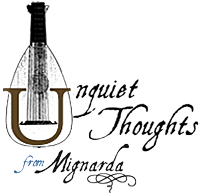Dowland, Marenzio and Lachrimae
 As we are in the midst of two separate recording projects, selected Italian lute songs from the 16th century, and music from Dowland’s Pilgrimes Solace (1612), it seems like a good opportunity to explore cross-references both of style and musical material used by Dowland.
As we are in the midst of two separate recording projects, selected Italian lute songs from the 16th century, and music from Dowland’s Pilgrimes Solace (1612), it seems like a good opportunity to explore cross-references both of style and musical material used by Dowland.
If one had to choose a generic ‘soundtrack’ for the 16th century Renaissance, it could be found in Italian music of the age. As with the visual arts, literature, and even clothing, the exuberant Italian style really set the international standard of excellence throughout Europe and the British Isles. Henry VIII was known to have loved frottole and was thought to have been entertained by the Italian lutenist, Vincenzo Capirola. Queen Elizabeth’s favorite composer (at least on that particular day) was said to have been the suspected spy, Alfonso Ferrabosco. And when England embraced new music of the 17th century, it was the Italian stile recitativo that took the country by storm.
In his remarks ‘To the courteous Reader’ in The First Booke of Songs or ayres of foure parts, with Tableture for the Lute (1597), Dowland mentions with great pride having received sundry letters from Luca Marenzio, “not thinking it any disgrace to be proud of the iudgement of so excellent a man.” Marenzio’s influence is acknowledged in Dowland’s very close re-working of Marenzio’s four-voice madrigal, ‘Ahi, dispietata morte‘ (1585), in a rather clumsy setting of the anonymous English text, ‘Would my conceit that first enforst my woe.’
Dowland’s most familiar lute solo is the ‘Lachrimae Pavan’ and his lute ayre, ‘Flow my teares fall from your springs’ (1600) is probably his best-known song. The hallmark falling tear motif found in these pieces was elaborated by Dowland in his circa 1604 instrumental collection Lachrimae, or Seaven Teares. In his descriptive monograph, Dowland, Lachrimae (1604), (Cambridge Music Handbooks), Cambridge, 1999, Peter Holman mentions a variety of speculative sources of the falling tear motif, and even mentions Marenzio’s six-part madrigal ‘Parto da voi,mio sole’ (1585) as a possible influence, having been ‘Englished’ in Musica transalpina (1588), a collection of Italian madrigals adapted to be sung to English texts.
I would like to add a further possible source of the falling tear motif: Marenzio’s four-part madrigal, ‘Piango che Amor‘ (Madrigali a quatto, cinqe e sei voci. Libro primo, 1588), which seems to have inspired Dowland as well as providing melodic and harmonic material for at least two other teary songs, ‘I saw my Lady weepe’ (1600) and ‘Flow not so fast yee fountains'(1603). Since this is meant to be a conversational blog post rather than an in-depth musical analysis, I’ll just mention that the falling tear motif is present, almost with neon flashing lights, as the final notes of the cantus in Marenzio’s madrigal, set to the word, pianto (weeping). Our recording of this song, with the lower three voice parts arranged for lute, will hopefully be available for comparison in late Spring 2011.
UPDATE 100513: Our recording of Marenzio’s ‘Piango che Amor‘ may be heard here and a video performance of our unique version of Dowland’s ‘Flow my teares fall from your springs’ may be seen and heard here.

Trackbacks & Pingbacks